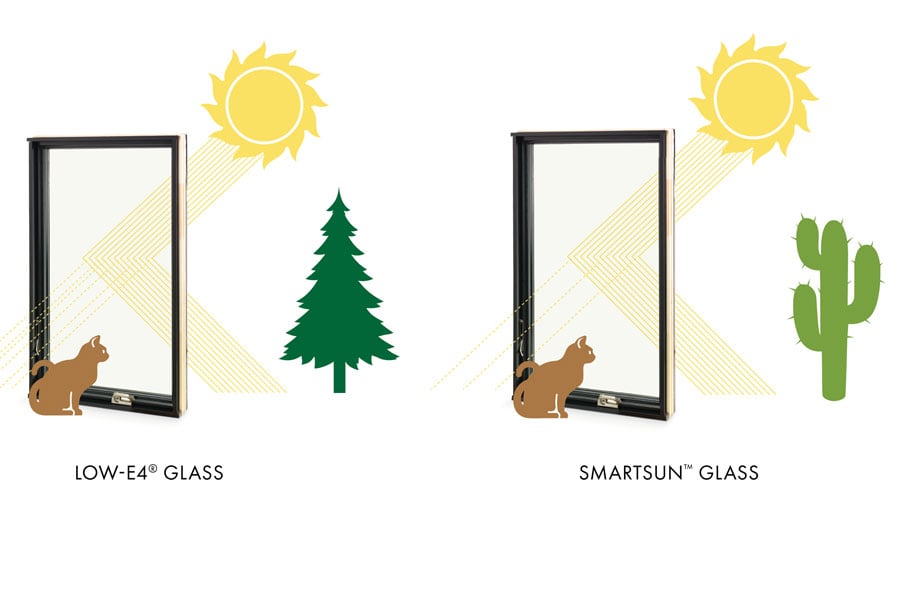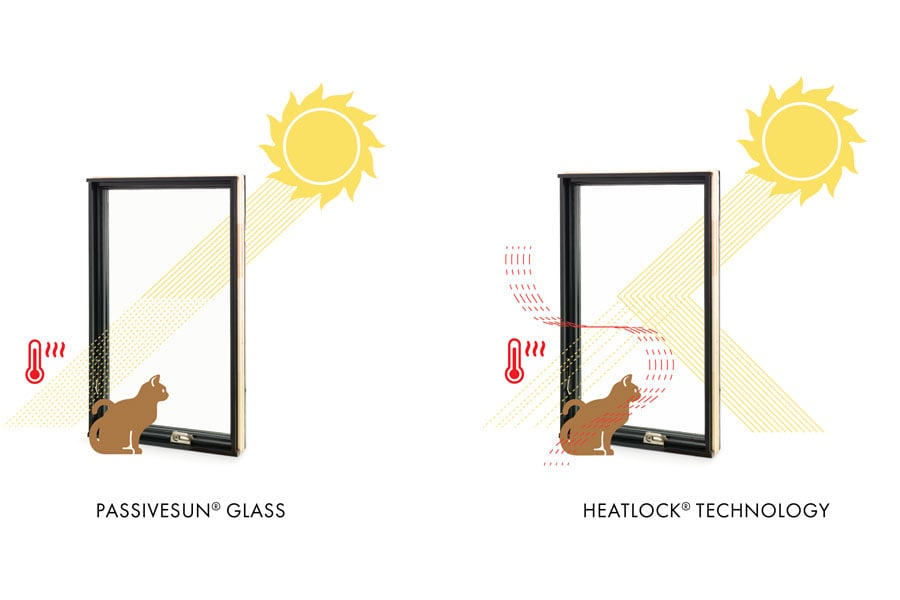Low-E glass: what are the benefits & how to pick it out

The right windows and doors can help make a home feel great, last longer, and operate more efficiently. But to choose well, it’s important to understand the role of low-emissivity (Low-E) glass coatings, including how they work, the benefits they provide, and the options available to achieve the right level of performance. Consider this your primer.
What is Low-E glass?
Low-E glass is window and door glass with microscopic, generally transparent coatings (Low-E coatings) that help to improve energy efficiency. These coatings can help block the sun’s heat in summer and prevent heat from escaping in winter. Whatever your climate demands — heating, cooling, or both — there are Low-E coatings available to help improve energy performance. Low-E coatings are widely available across the window and door industry, but not every company offers the option to add Low-E coatings standard with all their products, as we do.
What are the benefits of Low-E glass?
Low-E glass helps make a home feel more comfortable and improve its efficiency. Certain Low-E coatings can also help reduce fading to flooring, fabrics, and other interior surfaces by reducing the amount of UV light that transmits through the glass. While reducing unwanted temperature fluctuations and UV rays, Low-E glass still allows in the light. Finally, Low-E glass can help windows and doors achieve the level of performance prescribed by code and by voluntary programs, like ENERGY STAR®.
How does Low-E glass work?
Metallic-based Low-E coatings help reflect heat, keeping it on the side of the glass where it originated. Coatings can be applied on multiple glass surfaces of an insulated glass unit (IGU). An IGU is two or more panes of glass sealed together with air spaces in between (see image below). We offer four “soft” coatings, which are applied to glass surfaces inside the IGU, while the “hard” coating we offer, called HeatLock® technology, is applied to the interior-side glass surface. Soft and hard coatings can also be combined to achieve the performance needed — see the next section for recommended options by climate.

Which Low-E glass works best in which climates?
Some coatings are better at insulating, making them more ideal glass options for northern climates, while others are better at blocking solar heat gain, making them ideal glass options for southern climates. There are also coatings that work in all climates, and then there’s our SmartSun™ glass, which works in both northern and southern climates while also blocking UV rays. All of this is to say that the best performing Low-E glass depends on the home’s location, as well as the home’s design and orientation, and the homeowner’s preferences. And often, the best performance for the situation is achieved by combining the correct soft Low-E coating with our hard Low-E coating, HeatLock technology. Here’s what you need to know to pick the right Low-E glass option for your project:
Low-E coatings for all climates
- Low-E4® glass is a good option in most applications because it helps reflect heat in the summer and helps keep heat inside in winter. This makes it ideal in any climate where both heating and cooling costs are experienced. It’s our trademarked Low-E glass construction and available on all our products.
- SmartSun™ glass gives the benefits of Low-E4 glass while also blocking 95% of UV rays. This makes it a good option in all climates, particularly the sunny West and mild South. It’s also ideally suited to spaces with direct sun exposure, such as southern or western-facing rooms. Find it available on all our products.

Low-E glass for northern climates
In addition to Low-E4 and SmartSun glass options, which both work well in four-season climates, here are some glass options to be aware of when selecting product for a climate where heating is more of a concern than cooling:
- PassiveSun® glass allows the sun to help heat the home in the winter when a low sun angle directs more energy through the glass. It’s made for climates where extensive heating is required and is ideally suited to passive homes. It’s available on all our products.
- HeatLock technology helps prevent heat from escaping a home’s interior. It’s made for the northernmost climates where heating (not cooling) is the primary energy use and works best where there is a whole-home air exchanger or a dehumidifier. Find it available on most of our products. It will always be offered in combination with a soft Low-E coating.
- PassiveSun glass with HeatLock technology is a combination that works well in a northern climate because it helps capture and retain the sun’s warming rays. This combination would be useful in a home that’s been designed according to passive house principles.

Low-E glass for southern climates
Again, both Low-E4 and SmartSun glass options work in all climates, but here are some other options to be aware of where cooling is more of a concern than heating:
- Sun glass is made to help block the sun’s heat and is tinted. Compared to SmartSun glass, its tint is more pronounced and it’s more effective at blocking the sun. It’s ideally suited for southern climates. Find it available on E-Series, A-Series, 400 Series, and 100 Series products, plus 200 Series patio doors.
- SmartSun glass with HeatLock technology is a combination that works well in mild to hot climates because it helps keep the air conditioning in while also reducing solar heat gain.

Understanding how glass coatings are combined
When coatings are combined to improve the performance of a dual-pane window, it will always be one of the four soft Low-E coatings with HeatLock technology — our hard coating option. HeatLock technology increases thermal performance by limiting how much heat escapes a home’s interior. It’s predominantly used in northern climates — for example, the glass option of PassiveSun glass with HeatLock technology. But, as mentioned above, HeatLock technology can also be combined with SmartSun glass for a high-performing glass option suitable to southern climates. These glass options can help meet code and requirements for voluntary programs, like ENERGY STAR. It’s important to keep in mind that HeatLock technology works best where the homeowner wants to increase thermal performance and has a whole-home air exchanger or dehumidifier.
Want to understand more about glass?